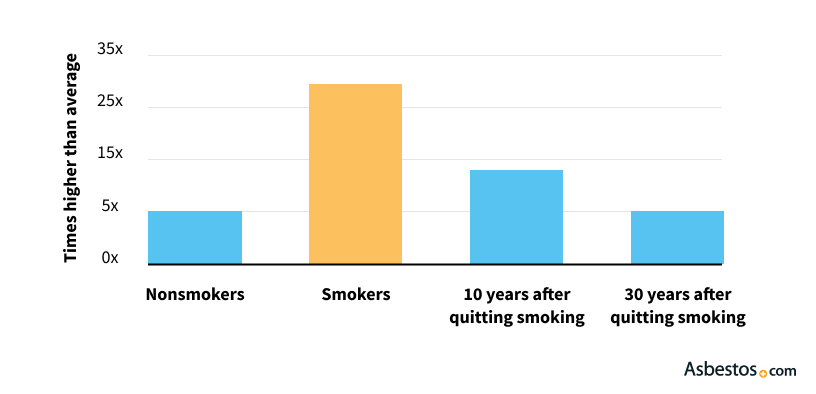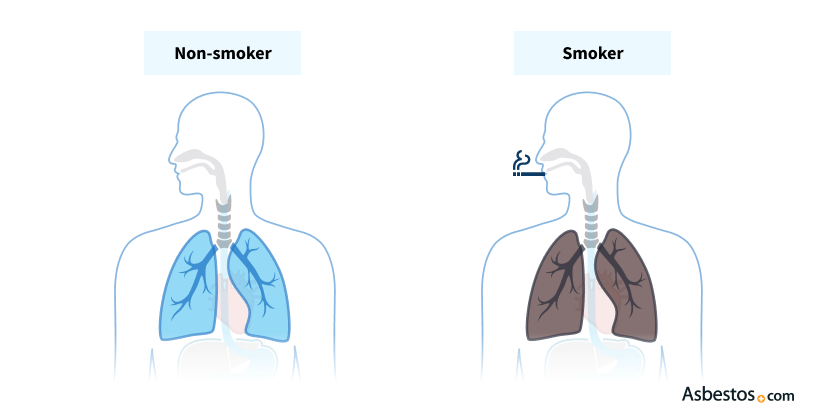Asbestos-Related Diseases and Smoking
Smoking alone or in combination with asbestos exposure doesn't increase the risk of developing mesothelioma. But the risk of lung cancer multiplies significantly among those exposed to asbestos and cigarette smoke. Both smoking and asbestos can cause lung cancer.

Written by: Michelle Whitmer | Scientifically Reviewed By Yvonne Waterman | Edited By Walter Pacheco
How Do Smoking and Asbestos Exposure Affect Health?
Smoking is the leading cause of preventable death in the U.S., and asbestos exposure is the No. 1 cause of occupational deaths worldwide. Exposure to both can have detrimental effects on respiratory health and cancer risk.
The combination of smoking and asbestos exposure greatly increases a person’s risk of developing lung cancer. It also may accelerate the onset of asbestosis and increase the severity of symptoms. Smoking affects the development and severity of asbestos-related diseases in several ways.
- Smoking represses the immune response to asbestos. Asbestos-exposed mice and human cell lines respond poorly to cigarette smoke. The parts of the immune system known to respond to asbestos get repressed. This increases the risk of lung cancer among people exposed to asbestos who smoke.
- Smoking impairs your lungs’ natural self-cleaning ability. The airways in your lungs are lined with tiny brush-like structures called cilia, which sweep dust particles out to keep your lungs clear. Smoking damages cilia, making it harder for them to expel pollutants, including asbestos fibers.
- Smoking increases inflammation and scarring in your lungs. Tobacco smoke and asbestos fibers can cause the buildup of scar tissue in your lungs. In addition, smoking changes how your immune system reacts to asbestos. It causes your lungs to develop even more scar tissue than they would otherwise. This can accelerate the onset of asbestosis.
- Smoking reduces your lungs’ ability to absorb oxygen. Tobacco smoke gradually destroys many of your lungs’ alveoli — the tiny air sacs that transfer oxygen into the bloodstream. Scar or cancer tissue formed around lodged asbestos fibers can make breathing difficult and smoking’s destruction of alveoli can make breathing even more difficult.
Smoking doesn’t increase the risk of developing mesothelioma among people exposed to asbestos. Scientists don’t know why this is true. They understand more about the increased risk of lung cancer. They believe it relates to the combined effects of smoking and asbestos.
Studies have estimated that between 50% and 80% of asbestos workers are smokers. This factor helps explain why asbestos-related lung cancer cases outnumber mesothelioma cases.

Many people may not realize asbestos causes lung cancer in addition to mesothelioma. As asbestos enters the lungs, it can damage the tissue within the lungs and the air sacs that help exchange air between your bloodstream and the outside air.
Smoking and Mesothelioma
Smoking hasn’t been directly linked to mesothelioma. The primary cause of malignant mesothelioma is asbestos exposure. However, smoking is a risk factor for developing asbestos-related lung cancer. If asbestos exposure has occurred, you may have an increased risk of developing mesothelioma.
It was the most depressing appointment of my life. I could have guessed maybe lung cancer because I had been a smoker. But mesothelioma? No. A cancer caused by asbestos exposure wasn’t even on my radar.
Decades of research haven’t found an increased risk of mesothelioma among asbestos workers who smoke. Only one study from 2002 found a common gene mutation among a group of smokers with mesothelioma. A 2013 study looking deeper into the topic found no relationship.
Smoking does worsen the pulmonary symptoms of mesothelioma and reduces your body’s overall ability to heal. Doctors advise all patients with cancer or respiratory illnesses to avoid tobacco smoke.

Access top mesothelioma specialists and get help scheduling appointments.
Start NowSmoking, Asbestos and Lung Cancer
The Centers for Disease Control and Prevention says smoking is the cause of 80% to 90% of lung cancer cases. Asbestos exposure is the primary cause in about 4% of U.S. cases, while a Japanese study showed asbestos may cause 12.8% of cases. A 2024 study confirmed asbestos exposure is associated with all types of lung cancer.
Both smoking and asbestos exposure can independently cause lung cancer. When combined, the risk of lung cancer becomes supra-additive, meaning the risk for smokers exposed to asbestos is greater than the sum of the individual risks. A 2013 study involving more than 50,000 medical records from insulation workers revealed how occupational asbestos exposure and smoking have a supra-additive effect on lung cancer death rates.
Death Rate of Asbestos Insulation Workers Associated With Smoking

Occupational asbestos exposure on its own was associated with a lung cancer death rate 5 times higher than average. When asbestos exposure was combined with smoking, the death rate was 28 times higher than average. Among those who also developed asbestosis, the death rate was 36.8 times higher.
The study also showed quitting smoking gradually reduces a person’s risk of lung cancer. Asbestos exposure’s health effects exposure are irreversible, however. Any amount of asbestos exposure contributes to the incidence of lung cancer, even in heavy smokers.
Smoking and Asbestosis
Smoking increases the risk of asbestosis among those exposed to asbestos. The Agency for Toxic Substances and Disease Registry’s research shows this risk.
Asbestosis is a chronic pulmonary disease in which the lungs undergo slow and repetitive scarring, or fibrosis. There is no known cure. The inhalation of asbestos fibers causes asbestosis. It’s most prevalent among workers with long and heavy exposure to asbestos.

A 1995 study concluded smokers have increased rates of asbestosis progression. An earlier report showed approximately 12% of asbestosis patients might develop lung cancer. Asbestos-exposed smokers with asbestosis have a significantly increased risk of lung cancer.
The effect of smoking on asbestosis has been a point of debate among researchers. Some experts believe smoking contributes to asbestosis and others challenge this notion. Significant evidence shows how much smoking can worsen symptoms of asbestosis, including breathlessness.
Asbestos in Cigarettes

In the U.S., one tobacco product is known to have been manufactured with asbestos as an ingredient: Kent Micronite filtered cigarettes. From 1952 to 1956, H&V Specialties manufactured cigarette filters for the Lorillard Tobacco Company using a type of asbestos called crocidolite.
Lorillard marketed Kent Micronites as the safest cigarettes ever invented, claiming high-tech industrial filtration technology inspired the design. Unfortunately, crocidolite is now widely considered the most toxic form of asbestos.
Although crocidolite was used in certain specialized filters, the crimped crepe paper of the Micronite cigarette filter didn’t prevent consumers from inhaling microscopic crocidolite fibers when they smoked Kent cigarettes. One study found a smoker could inhale “an average of 170,000 crocidolite airborne structures” from only 2 puffs on a Kent Micronite.
In general, cigarette filters don’t make cigarettes significantly safer. The filters typically only trap the largest tar particles, allowing most of the toxic substances in cigarettes to pass through. The Kent Micronite filter made smoking more dangerous, adding asbestos to the list of cancer-causing substances smokers were exposed to.
Commonly Asked Questions About Asbestos & Smoking
- What happens if you smoke and work with asbestos?
-
Asbestos workers who smoke have a significant risk of developing lung cancer. If they develop asbestosis, smoking worsens symptoms and may make the disease progress at a faster rate.
- What is the synergy between asbestos and smoking on lung cancer risk?
-
Asbestos workers who smoke are 28 times more likely to die of lung cancer than the general population. Those who receive an asbestosis diagnosis have a higher risk. Asbestos-exposed smokers who develop asbestosis are 36.8 times more likely to die of lung cancer.
- Why are asbestos workers who smoke urged to quit?
-
Asbestos workers who smoke should quit smoking to reduce their risk of developing lung cancer. Exposure to cigarette smoke and asbestos is associated with a supra-additive risk of lung cancer. Join a smoking cessation program immediately if you work with asbestos products.
Connect with Our Community

Have a question? Contact one of our Patient Advocates and get the answers you need.

Connect, share stories and learn from the experiences of others coping with mesothelioma in one of our support groups.

We help support charities, hospitals and awareness groups working to help people impacted by asbestos and cancer.







